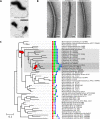Giant flagellins form thick flagellar filaments in two species of marine γ-proteobacteria
- PMID: 30462661
- PMCID: PMC6248924
- DOI: 10.1371/journal.pone.0206544
Giant flagellins form thick flagellar filaments in two species of marine γ-proteobacteria
Abstract
Flagella, the primary means of motility in bacteria, are helical filaments that function as microscopic propellers composed of thousands of copies of the protein flagellin. Here, we show that many bacteria encode "giant" flagellins, greater than a thousand amino acids in length, and that two species that encode giant flagellins, the marine γ-proteobacteria Bermanella marisrubri and Oleibacter marinus, produce monopolar flagellar filaments considerably thicker than filaments composed of shorter flagellin monomers. We confirm that the flagellum from B. marisrubri is built from its giant flagellin. Phylogenetic analysis reveals that the mechanism of evolution of giant flagellins has followed a stepwise process involving an internal domain duplication followed by insertion of an additional novel insert. This work illustrates how "the" bacterial flagellum should not be seen as a single, idealised structure, but as a continuum of evolved machines adapted to a range of niches.
Conflict of interest statement
The authors have declared that no competing interests exist.
Figures



Similar articles
-
Characterization and functional analysis of seven flagellin genes in Rhizobium leguminosarum bv. viciae. Characterization of R. leguminosarum flagellins.BMC Microbiol. 2010 Aug 17;10:219. doi: 10.1186/1471-2180-10-219. BMC Microbiol. 2010. PMID: 20716375 Free PMC article.
-
Multiple Flagellin Proteins Have Distinct and Synergistic Roles in Agrobacterium tumefaciens Motility.J Bacteriol. 2018 Nov 6;200(23):e00327-18. doi: 10.1128/JB.00327-18. Print 2018 Dec 1. J Bacteriol. 2018. PMID: 30201783 Free PMC article.
-
Bacterial Flagellins: Does Size Matter?Trends Microbiol. 2018 Jul;26(7):575-581. doi: 10.1016/j.tim.2017.11.010. Epub 2017 Dec 16. Trends Microbiol. 2018. PMID: 29258714 Review.
-
Formation of a single polar flagellum by two distinct flagellar gene sets in Sphingomonas sp. strain A1.Microbiology (Reading). 2015 Aug;161(8):1552-1560. doi: 10.1099/mic.0.000119. Epub 2015 May 26. Microbiology (Reading). 2015. PMID: 26018545
-
Flagella of halophilic archaea: differences in supramolecular organization.Biochemistry (Mosc). 2014 Dec;79(13):1470-82. doi: 10.1134/S0006297914130033. Biochemistry (Mosc). 2014. PMID: 25749160 Review.
Cited by
-
Early stage of biofilm assembly on microplastics is structured by substrate size and bacterial motility.Imeta. 2023 Jun 7;2(3):e121. doi: 10.1002/imt2.121. eCollection 2023 Aug. Imeta. 2023. PMID: 38867926 Free PMC article.
-
The Remarkable Dual-Level Diversity of Prokaryotic Flagellins.mSystems. 2020 Feb 11;5(1):e00705-19. doi: 10.1128/mSystems.00705-19. mSystems. 2020. PMID: 32047063 Free PMC article.
-
Phenotypic and genotypic characterization of Marinobacterium weihaiense sp. nov. and Marinobacterium marinum sp. nov., isolated from marine sediment, and genomic properties of the genus Marinobacterium.Microb Genom. 2024 Jan;10(1):001182. doi: 10.1099/mgen.0.001182. Microb Genom. 2024. PMID: 38265428 Free PMC article.
-
Identification and characterization of the proteolytic flagellin from the common freshwater bacterium Hylemonella gracilis.Sci Rep. 2020 Nov 4;10(1):19052. doi: 10.1038/s41598-020-76010-8. Sci Rep. 2020. PMID: 33149258 Free PMC article.
References
-
- Rossez Y, Wolfson EB, Holmes A, Gally DL, Holden NJ. Bacterial flagella: twist and stick, or dodge across the kingdoms. PLoS Pathog. 2015;11: e1004483 10.1371/journal.ppat.1004483 - DOI - PMC - PubMed
-
- Wang F, Burrage AM, Postel S, Clark RE, Orlova A, Sundberg EJ, et al. A structural model of flagellar filament switching across multiple bacterial species. Nat Commun. 2017;8: 960 10.1038/s41467-017-01075-5 - DOI - PMC - PubMed
-
- Chen S, Beeby M, Murphy GE, Leadbetter JR, Hendrixson DR, Briegel A, et al. Structural diversity of bacterial flagellar motors. EMBO J. 2011;30: 2972–2981. 10.1038/emboj.2011.186 - DOI - PMC - PubMed
-
- Paradis G, Chevance FF V., Liou W, Renault TT, Hughes KT, Rainville S, et al. Variability in bacterial flagella re-growth patterns after breakage. Sci Rep. Springer US; 2017;7: 1282 10.1038/s41598-017-01302-5 - DOI - PMC - PubMed
-
- Yonekura K, Maki-Yonekura S, Namba K. Complete atomic model of the bacterial flagellar filament by electron cryomicroscopy. Nature. 2003;424: 643–650. 10.1038/nature01830 - DOI - PubMed
Publication types
MeSH terms
Substances
Grants and funding
LinkOut - more resources
Full Text Sources
Molecular Biology Databases

